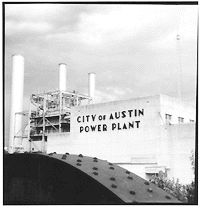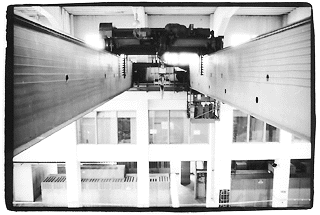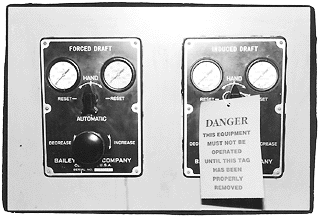Light and Power
The Future of Seaholm
By Kayte VanScoy, Fri., May 8, 1998
|
|
Beyond its many attractive design features, Seaholm has got what every piece of real estate wants - location, location, location. Between the hike and bike trail which traces directly along Shoal Creek east of the plant and ducks under Cesar Chavez to meet up with the trail around the lake, the footbridge which the City Council recently committed to build across the lake near the Lamar Street bridge, and the railroad tracks running directly into the building, Seaholm is sitting pretty to become a tourist mecca. Add to this its proximity to Palmer Auditorium, the Convention Center, the Children's Museum, and the hopping warehouse district, and the possibilities for Seaholm's future begin to really stir up excitement.
Furthermore, with 110,00 square feet of interior space and, in some places, 95 feet of open space from floor to ceiling, Seaholm could house just about anything from a small shopping mall to a performing arts facility. The abundance of fascinating machinery, from the mammoth turbines to the quaint panels of monitoring equipment, make thoughts of a science and technology museum a natural. Gallons of light pouring in from glass-block walls and clerestory windows bring to mind viewing art, dining, shopping, and relaxing along Town Lake. Best of all, with the abundance of space, all of these things can probably take place within the walls of Seaholm at the same time.
|
|
Once Seaholm is converted to public use, the transformation of the Town Lake area from an industrial district will be complete. For most of this century, the Colorado River was used how all rivers were once used, as catalysts for industry by way of being both a thoroughfare for goods, and a dumping ground for the by-products of manufacturing. In 1910, when Austin's first power plant was sited where Seaholm now sits, it shared the neighborhood with a mattress factory and other industrial uses. Over time, luxury hotels took the place of factories and the river was dammed into a lake, preventing flooding and making the hike and bike trail with its accompanying trees and flowers possible. Now Seaholm is the sore industrial thumb in a district overflowing with parks, art, and entertainment.
Its decommissioning, scheduled for the end of 2000, comes at a time of unprecedented public enthusiasm about Austin's downtown, and during an equally unprecedented wave of public discussion on Austin's growth. Seaholm will likely be the beneficiary of that enthusiasm as plans for its conversion will rely heavily on public input. Although a round of open meetings and tours of the facility by the council-appointed Seaholm Reuse Planning Committee recently ended, with a year and a half to its decommissioning date, it is likely that the public discussion on Seaholm has only just begun.
But, although everyone agrees that Austin's cup runs over with the opportunities at Seaholm, the conversion of the plant is not without controversy. First, there is the intake facility, the Seaholm-esque building just across Cesar Chavez from the facility, directly on Town Lake. The intake building is equally as fabulous a space as Seaholm itself, though it is less than one-tenth the size. The 25-foot ceilings, and a spot not only on but in Town Lake, immediately bring to mind an elegant dining atmosphere. However, past battles with nearby residents have shown that conversion of the building to that type of use will face powerful detractors who fear that such a move would turn the hike and bike trail into a bar district. Not to mention that parking for the intake building is nonexistent.
Which brings us to the one and only downside in the entire Seaholm discussion - parking. Despite the abundance of trails surrounding the facility, and despite the fact that every recent discussion of light rail includes the intention to use Seaholm as a stopping point, the plain fact is that Texans like to drive, and Seaholm is going to need a parking lot. And if even half of the dreams for Seaholm become a reality, it's going to have to be a pretty big one, too.
|
|
Fortunately, there is already a five-acre plot of land abutting the Seaholm site to the west which is already partly paved for parking. Unfortunately, using it for Seaholm is not going to be simple. The land has a long history which began when approximately 100 acres of land called the Sand Beach Reserve was sold to the city by the state in 1945 for the nominal fee of $10,000, with the express caveat that the land be used for public purposes. The small piece of that land which lies to the west of Seaholm went through another struggle in the early 1980s when then-mayor Ron Mullen was caught in a land deal trying to develop an office building on the site. When the office development fell through, Lumbermen's Investment Corp. foreclosed on that portion of the land. Lumbermen's executives were not available for comment.
Most recently, the fight over Sand Beach has been a four-way tug-of-war between Lumbermen's, Seaholm boosters, environmentalists, and the state. Those involved in Seaholm's reuse plans say that Lumbermen's will sell the land back to the city, but only at the inflated Eighties prices at which they purchased it. Otherwise, they say, Lumbermen's is threatening to build a 300-unit apartment complex on the site. Environmentalists don't want to see land that was meant to be a park developed for apartments, or for parking, and point to the Poleyard site, directly to the north of Seaholm, as a better option for parking. However, the Poleyard is part of the City Council's plan to develop apartment complexes downtown. In this whole debate over Sand Beach, only one outcome is certain. When Seaholm is developed, it is going to need a parking lot nearby.
However, it is not yet time to get bogged down with controversy. The City Council will be looking for plenty of public discussion about the recommendations that the Seaholm Reuse Committee will bring later this month. Then the job of deciding how to pay for the redevelopment and which lucky vendors will get to set up shop in Seaholm will begin. In all the debate that is likely to ensue, Austin will do well to keep in mind the glorious public building which is at stake.
Got something to say on the subject? Send a letter to the editor.









